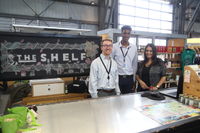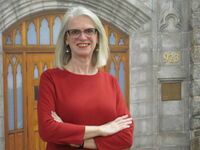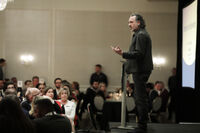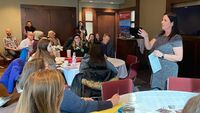By Lezlie Lowe |
University research often gets a bad rap for being out of touch with the lives of everyday folks. But the work of four Saint Mary’s faculty members, profiled here, flies in the face of that. The applied fieldwork and experiments of these professors, and their students, proves that research can make a difference in the areas of local food, disease diagnosis, and rural sustainability. The applied research of Saint Mary’s, as a leader in the field, is causing ripples of change not just in our province, but around the world.
People buy groceries, take them home, make meals. Repeat. How much innovation can there be?
A cart load, says Saint Mary’s associate professor of marketing Dr. Ramesh Venkat. Venkat is director of the David Sobey Centre for Innovation in Retailing and Services, whose mandate centres around applied research to help the Canadian retail sector become more innovative and competitive.
That raison-d’être is playing out at The Shelf, a modular retail space at the Seaport Farmers’ Market on the Halifax waterfront, where the David Sobey Centre has established a “living retail lab” to test innovations and conduct research.
These experiments, Venkat says, are “really about supporting local business.”
The Shelf carries food and craft products from vendors within the market, operating weekdays when not all vendors are on site, and on weekends in a smaller space with fewer products.
The Shelf’s focus on local producers and vendors dovetails nicely with the School of Business’s commitment to community. “Being part of (The Shelf) allows us to support local entrepreneurs,” says Venkat. “It’s a big issue for us at the school; we are all about having an impact on the local community.”
The first hands-on work at The Shelf was instituting a point-of-sale system. In August, they began testing student-designed tags on select products, similar to clothing store anti-theft devices. The tags allow consumers, using their smartphones, to learn more about products and their origins. In September, an experiment began that involved short videos of producers talking about their products and the back stories of their brands. When consumers passed a display, a video automatically played. The goal was to determine if the video affected consumers’ choice of one brand over another.
The pay-off for these experiments goes two ways, Venkat says.
The Shelf gets to improve its competitiveness within the local food and craft sector without investment, while Saint Mary’s researchers get to test in real time whether their innovations are successful.
There’s a not-too-shabby return on investment for Venkat, either. “My background is customer research,” he says, “but I have a passion for tech. With The Shelf, I get to work with retailers and solve real problems.”
Oh, no big deal — Dr. Rituparna Kanungo and her students are only tied up in unravelling the greatest mysteries of the universe.
“What we are aiming at,” explains the professor in Saint Mary’s department of Astronomy and Physics, “is understanding the roots of our existence and all matter around us.”
Part of Kanungo’s research uses high-energy protons to create radioactive isotopes and discover new phenomena in how nature builds them; this work also involves the development of radiation detectors. This impactful research brings to the university, and Canada, international reputation and knowledge advantage. It sounds abstract, but, Kanungo argues, empowers students with knowledge on radiation and isotopes.
This research work happens at TRIUMF, Canada’s national laboratory for particle and nuclear physics and accelerator-based science.
Located on the campus of the University Of British Columbia, TRIUMF houses the world’s largest cyclotron — particle accelerator. The institute is a joint venture of 19 Canadian universities, Saint Mary’s among them. Kanungo is a TRIUMF Affiliate Scientist. The institute is what brought her to Canada and the university’s connection to TRIUMF is what drew her to Saint Mary’s.
Kanungo’s regular travels from Nova Scotia to BC also support one of her fundamental goals as a scientist — to bring Canada’s east and west coasts together through cooperative learning and the sharing of ideas. She strives to open the door of the world’s top-research centers in nuclear science to the students of Saint Mary’s University. “If we don’t expand our fundamental knowledge, society will not advance - we would still be stuck wondering if the earth goes around the sun or the sun goes around the earth.”
Investigations into the nature and use of sub-atomic particles are vast and varied. Research in fundamental nuclear science made discoveries that have eventually led to numerous applications in everyday life, such as the development of positron emission tomography (PET) scanners for diagnosing cancer. TRIUMF also is harnessing proton beams to treat ocular melanoma, and the rare isotope facility that Kanungo and her team utilizes for fundamental research also enables the production of medical isotopes, which allow clinicians to diagnose and treat diseases — all infinitely related to the health of populations around the world.
For her students, TRIUMF is first-hand exposure to real-life work. “It’s something very special. Not very many places have that opportunity. It shows that the capacity of Saint Mary’s is not restricted to the campus walls.”
Dr. Karly Kehoe is a historian, but the fruits of her current research are grounded in the Nova Scotia of today, and of the future. Historical Perspectives and Community-Building in Rural Nova Scotia is a joint proposed research project between Kehoe, Canada Research Chair in Atlantic Canada Communities, and Dr. Alexander MacLeod, an associate professor of English and Atlantic Canada Studies.
The pair take their inspiration from the impending decline in standard of living, public services, and population warned of in the 2014 Ivany report on building Nova Scotia’s new economy.
This “significant and prolonged” decline will be felt most in rural areas, where two-fifths of Nova Scotians live, and where Kehoe and MacLeod have deep roots. “It’s personal for us,” says Kehoe, who grew up in Margaree Forks, and for MacLeod, who was born in Inverness and comes from a large family that has lived in Dunvegan for more than 200 years.
Kehoe and MacLeod’s project sees the two making use of Saint Mary’s unique expertise in Atlantic Canada Studies, combined with a doggedness for community engagement. MacLeod calls it “showing up.” It’s a remedy to the big divide he sees between the city and its rural communities.
The proposed project aims to look at the challenges faced in rural communities, how they relate to historic difficulties confronted in the same geographic areas, and how the university can help improve, in part, economic sustainability — supporting rural Nova Scotians to better understand their cultural pasts so that they can build more sustainable futures.
The majority of this on-the-ground work will take place in Inverness County and it will focus on youth, who Kehoe and MacLeod believe hold the key to all positive future change.
“Read the local papers in any small community,” MacLeod says. “It’s all about young high school students who are pursuing their passions and making a difference. They’re actively inspiring others.”
Already for the project, Kehoe and MacLeod have met with high school students to ask them: what would it look like if Saint Mary’s was invested in their community the same way the University is invested in the fabric of the city? How could Saint Mary’s help rural areas harness their power, reach their potential, and use the knowledge of the past to help inform the future?
Finding those answers and acting on them, Kehoe and MacLeod suggest, “is what a university is supposed to be doing.”




